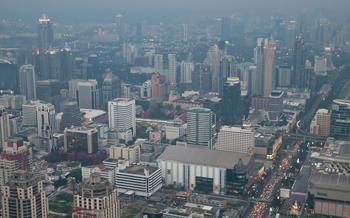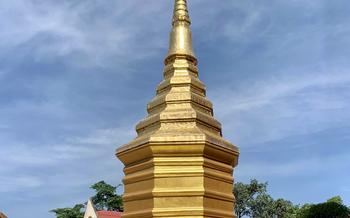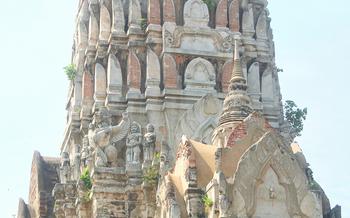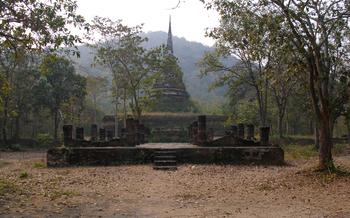
Wat Ko Kaew Suttharam
- History and Significance of the Temple
- Admission Fees and Timings
- Exploring the Temple Grounds
- The Buddha Images and Statues
- The Bell Tower and Giant Bell
- The Sala Kaew Ku (Glass Pavilion)
- Pilgrimage and Religious Significance
- Local Markets and Street Food
- Accommodation and Hotels Nearby
- Insider Tip: Hidden Gems to Explore
History and Significance of the Temple
Wat Ko Kaew Suttharam, also known as Wat Ko Kaew, is a Buddhist temple situated in the Phetchaburi Province of Thailand, approximately 120 kilometers southwest of Bangkok. The temple holds significant historical and religious importance, as it is believed to have been constructed around the 18th century during the Ayutthaya period. It is dedicated to the revered Thai Buddhist monk Somdet Phra Sangkaratcha (Pae) of the Rattanakosin era. The temple has undergone several renovations over the years, and its current appearance reflects a blend of traditional Thai and Chinese architectural styles. Wat Ko Kaew Suttharam is renowned for its exquisite Buddha images, grand chedi, and serene atmosphere, attracting numerous pilgrims and visitors seeking spiritual tranquility and cultural immersion.
Admission Fees and Timings
A visit to Wat Ko Kaew Suttharam is free of charge for both local and foreign visitors. The temple is open to the public daily from 8 AM to 5 PM, with the exception of certain Buddhist holidays and festivals. Peak season generally falls between November and February, while the off-peak season runs from June to September.
While crowds are typically smaller during the off-season, the temple still sees a steady flow of visitors throughout the year. For those who prefer a more tranquil experience, it is advisable to plan their visit on weekdays and avoid weekends or public holidays. By visiting during the early morning or late afternoon, you can also enjoy the temple's serene atmosphere with fewer people around.
Exploring the Temple Grounds
The temple complex of Wat Ko Kaew Suttharam is a vast and sprawling one, offering visitors a tranquil and serene environment to explore. The layout of the temple is well-organized, with the main structures arranged symmetrically around a central axis. The complex is divided into several areas, each with its own unique features and significance.
The most prominent landmark in the temple is the Grand Chedi, which is located at the heart of the complex. Surrounding the chedi are several other notable structures, including the Ubosot (Ordination Hall), the Bell Tower, the Sala Kaew Ku (Glass Pavilion), and various other shrines and stupas.
Visitors are free to explore the temple grounds at their own pace, although it is recommended to follow the suggested route to ensure a comprehensive and enjoyable experience. The temple is open to the public every day of the week, although some areas may be closed during certain times for religious ceremonies or maintenance.
When visiting the temple, it is important to dress respectfully and behave appropriately. Visitors should refrain from wearing shorts, tank tops, or other revealing clothing. It is also important to maintain silence and avoid disturbing the peace and tranquility of the temple grounds.
The Buddha Images and Statues
Wat Ko Kaew Suttharam is home to a diverse collection of Buddha images and statues, each possessing unique characteristics and religious significance. The temple houses various types of Buddha images, including standing, seated, and reclining postures, representing different periods and styles of Buddhist art. These exquisite sculptures are crafted using various materials such as bronze, gold, silver, and wood, showcasing the exceptional craftsmanship and artistry of Thai artisans. The Buddha images exhibit intricate details, serene expressions, and symbolic hand gestures, each conveying profound teachings and spiritual messages. They serve as objects of veneration and inspiration for Buddhist devotees, who offer prayers and make offerings to seek blessings and guidance.
The Bell Tower and Giant Bell
Standing majestically as a symbol of devotion and mindfulness, the bell tower of Wat Ko Kaew Suttharam is a remarkable sight to behold. Its towering structure commands attention, inviting visitors to explore its historical significance and cultural allure.
The bell tower, also known as the "Hor Rakhang," is crafted with intricate architectural details that showcase the artistry and craftsmanship of the temple's builders. Its design blends traditional Thai elements with contemporary influences, creating a unique and harmonious aesthetic.
The highlight of the bell tower is undoubtedly the giant bell, which is one of the largest in the region. Cast from a special alloy, the bell produces a deep, resonant sound that echoes throughout the temple grounds and beyond. Its majestic tone is said to carry blessings and divine protection to those who hear it.
In the past, the bell was rung to signal important events, religious ceremonies, and to gather the community for announcements. Today, it serves as a symbol of continuity, reminding visitors of the rich traditions and spiritual practices that have been passed down through generations.
Visitors are welcome to climb the bell tower for a closer look at the bell and to experience the stunning views from its elevated platform. The panoramic vista offers breathtaking views of the temple grounds, the surrounding countryside, and the distant hills.
Whether you choose to admire the bell tower from afar or venture up close to marvel at its grandeur, this iconic landmark is a must-see for anyone visiting Wat Ko Kaew Suttharam. Its enduring presence represents the temple's dedication to preserving cultural heritage and fostering a sense of community and devotion.
The Sala Kaew Ku (Glass Pavilion)
Amidst the lush greenery of Wat Ko Kaew Suttharam, visitors will find a captivating structure known as the Sala Kaew Ku or the Glass Pavilion. This unique building stands out for its striking design and construction. The pavilion is entirely made of glass, creating a fascinating interplay of light and reflections.
The Sala Kaew Ku serves as a serene space for contemplation and meditation. Its transparent walls allow visitors to enjoy panoramic views of the surrounding gardens and the majestic chedi. The pavilion's glass construction creates a sense of harmony between the natural and spiritual realms, inviting visitors to connect with the beauty of their surroundings.
Inside the Sala Kaew Ku, visitors will find a collection of Buddha images and statues, each with its own unique story and symbolism. These sacred objects are beautifully illuminated by the natural light that filters through the glass walls, creating an ethereal and awe-inspiring atmosphere.
The Sala Kaew Ku is not just a place of worship but also a popular spot for photography enthusiasts. The combination of glass, nature, and religious iconography makes for stunning and Instagram-worthy shots. Visitors can capture unique perspectives of the temple complex and create lasting memories of their visit to Wat Ko Kaew Suttharam.
Pilgrimage and Religious Significance
Wat Ko Kaew Suttharam holds deep religious significance for Buddhist pilgrims from Thailand and beyond. The temple is a renowned center for meditation and spiritual retreats, attracting devotees seeking inner peace and enlightenment. Visitors can witness the reverence and devotion of the pilgrims as they perform various rituals and ceremonies within the temple grounds.
Pilgrims often make offerings of flowers, incense, and candles at the numerous Buddha images and shrines scattered throughout the complex. They engage in prayer and meditation, seeking blessings and guidance from the divine. The temple's serene atmosphere and sacred energy create a conducive environment for spiritual contemplation and self-reflection.
The annual Buddhist festivals and events held at Wat Ko Kaew Suttharam draw large crowds of pilgrims and devotees. These celebrations showcase traditional Thai religious customs and rituals, offering visitors a glimpse into the vibrant spiritual heritage of the country. The temple's role as a spiritual sanctuary and pilgrimage site reinforces its importance in the hearts and minds of the Thai people.
Local Markets and Street Food
A visit to Wat Ko Kaew Suttharam is not complete without sampling the delicious local food and street delicacies offered in the vicinity of the temple. Just a short walk away, visitors can find a vibrant market filled with stalls selling an array of mouth-watering dishes. From classic Thai curries and stir-fries to fresh fruits and sweets, there's something to satisfy every palate. Food lovers can indulge in the flavors of Thailand's renowned street food scene, where vendors showcase their culinary skills and offer tantalizing dishes at affordable prices. Be sure to try the local favorites such as pad thai, mango sticky rice, and som tam (green papaya salad) to experience the true essence of Thai cuisine. The market is a great place to interact with locals, learn about their culture, and immerse oneself in the vibrant atmosphere of Phetchaburi's street food scene.
Accommodation and Hotels Nearby
If you're planning to extend your stay in Phetchaburi and explore the city's other attractions, there are several accommodation options available near Wat Ko Kaew Suttharam. From budget-friendly guesthouses to luxurious resorts, you'll find a range of choices to suit your needs.
For a comfortable and convenient stay, consider hotels located within walking distance of the temple. These hotels often offer amenities such as swimming pools, fitness centers, and restaurants, providing a relaxing and enjoyable stay.
If you're traveling on a budget, there are several affordable guesthouses and hostels in the vicinity. These accommodations typically offer basic amenities like clean rooms, shared bathrooms, and free Wi-Fi.
Whichever type of accommodation you choose, be sure to book in advance, especially during peak tourist seasons, to avoid disappointment.
Here are some tips for finding the best hotel deals:
- Use online travel booking platforms to compare prices and amenities across different hotels.
- Look for discounts and special offers, particularly during the low season.
- Consider booking directly with the hotel to inquire about any exclusive promotions or packages.
- If you're flexible with your dates, try to avoid weekends and holidays when prices tend to be higher.
Insider Tip: Hidden Gems to Explore
Beyond the main attractions, Wat Ko Kaew Suttharam hides several lesser-known gems waiting to be discovered. Explore the serene Meditation Garden tucked away in a tranquil corner of the temple, where you can find inner peace and tranquility. Nature enthusiasts will delight in the secluded Lotus Pond, home to a vibrant array of lotus flowers that bloom in radiant colors. Photography enthusiasts can capture unique perspectives from the Rooftop Terrace, offering panoramic views of the temple grounds and the surrounding landscape.
For a glimpse into local life, venture outside the temple walls and explore the nearby villages. Engage with friendly locals, savor delicious street food, and immerse yourself in the vibrant culture of Phetchaburi. Don't miss the opportunity to visit the nearby Wat Yai Suwannaram, a stunning temple known for its impressive reclining Buddha statue. With its hidden treasures and authentic experiences, Wat Ko Kaew Suttharam promises an unforgettable journey for those who seek to explore beyond the ordinary.




